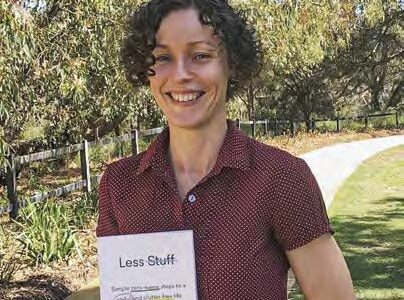
“Mess and clutter stand in the way of our productivity, stress us out and keep us stuck. Our stuff stands in the way of the lives we dream about,” writes Lindsay Miles. “When I think about why I was hoarding stuff in the first place, there were a couple of reasons. One was that I cared about waste; I wasn’t going to sling perfectly useful items in the bin,” she continues. “However, there was more to it than that. I’d never needed to declutter. I’d never learned to let things go,” confesses Miles in the introduction of her book, Less Stuff: Simple Zero-Waste Steps to a Joyful and Clutter-Free Life (Hardie Grant, 2019, 224 pages). Due to a spacious childhood room and an even more spacious attic, the author admits, “There was never any need to get rid of anything, nor any inclination to do so.”
She goes on to say, “Somehow I’d let the fact that stuff was inherently useful blur the real question: Was it useful to me?” If you are someone who cares about the environment and could benefit from minimizing your possessions, this is the book for you. Miles focuses on the emotional causes of materialism and clutter for a full third of the book before tackling the room-by-room process of right-sizing your possessions. The final third deals with responsibly separating from those items you no longer need and learning from the experience so that you can continue to live clutter-free long after your initial journey through the process.
Minimalism is a lifestyle that turns its back on consumerism and materialism. A person discovers what they really need and they let go of the rest. This reduces the time and debt that go along with the acquisition, maintenance, and storage of things, leaving more time for the experiences and relationships that bring joy. The goal of the zero-waste lifestyle is to refuse products and packaging that are not necessary and reduce consumption to what is needed.
Miles believes the goals of zero waste and minimalism are compatible: “At the heart of both is the idea of intentional living. Realising what we truly need, making do and choosing well.”
Obstacles to right-sizing our possessions are many. Miles writes, “Advertisements tap in to what we value, and then activate these values to persuade us to buy products.” Defining your values builds resistance to these messages. A “scarcity mindset” tells us there is never enough, and we fear letting go of things we may need at a later time. Weighing the time, distance, and money required to replace an item against the emotional and financial cost of storing it can help you overcome this objection.
We hold onto items for the very reason we should let them go –– we do not use them. We regret the purchase and think disposing of the item is admitting failure. Miles suggests, “Don’t think of it as failing, because it isn’t. There was a lesson in there to be learned. We can take the lesson on board and let the item go.” Many unused items are related to our “fantasy self,” that person who is going to lose a few pounds, take up a new hobby, or tackle a home improvement project. “When we like an idea, but not enough to prioritise it, the items that are attached to the idea remain unused,” says the author. “We need to recognise our fantasy self in order to let these items go.”
Miles’ action plan calls for a labeled, six-box system: donate, sell, recycle, repair, junk, and other. While most of these categories are self-explanatory, “other” includes items you are undecided about, which belong to someone else, or for which you need more time to evaluate. Room by room, every item is picked up and evaluated. “Once a box is full, or you have a couple of boxes of the same category piling up, act on them,” encourages Miles. This batching of items brings efficiency. If dealt with one at a time, the process will take too long. And, if nothing is disposed of until the end, there will be no sense of progress and you will feel overwhelmed.
Photo courtesy of Lindsay Miles.
